




MALAGA politicians have blasted big wigs in Madrid after their long-held dreams of a Costa del Sol train were dismissed as ‘complicated and expensive’.
The backlash came after Spain’s Transport Minister Oscar Puente (pictured) made the remarks in parliament this week, admitting there were ‘no feasible plans’ for the project - despite €600,000 having been pumped into studies over the past five years. Puente insisted that extending the current line from Fuengirola would be slow and ‘uncompetitive’, with many people



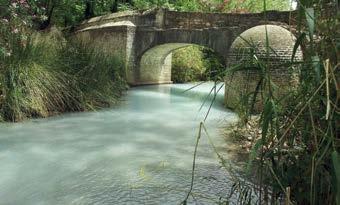
still preferring to get in their cars. He added that the terrain would prove difficult to build through while threatening the Costa del Sol’s real estate market. He concluded that ‘it seems complicated to me to make a bet on a solution at least within a reasonable period of time.’
Rocio Diaz, housing and development minister for Andalucia, hit back at complaints about costs, arguing that it has ‘guarantees of success’ given its dire economic need.
“It is a project with strong socio-economic and environmental viability, not only because of the potential demand but also due to the gridlock on the roads running along the Costa del Sol,” she said.
“We should sit down together and talk and assess the need for a train that extends to Marbella - or even as far as Algeciras, or at least to see about extending the Malaga to Fuengirola train.”
Francisco Salado, president of the Malaga Province Council, complained


that ‘the Government has already clearly demonstrated that it has no will to build the train to Marbella , Estepona and Algeciras or to solve the mobility problems on the Costa del Sol.’
SHELVED: How a costa train line might look
“The residents of the Costa del Sol are not second class citizens and deserve the same mobility and transport infrastructures that exist, are planned and built in the other large metropolitan areas of Spain,” he fumed.
THE Junta de Andalucia and three major private hospital groups have vowed to stop handing out Nolotil to at-risk patients after being contacted by the Olive Press.
Marbella’s leading Helicopteros Sanitarios group, HCB and Grupo Ribera all told this paper they were committed to banning the drug for northern European and American patients. The companies said they were following important central government advice issued in 2018, which came about after medical campaigner Cristina del Campo took the issue to the national courts. News of their re-commitment comes after we launched a campaign in February to stop handing out the lethal painkiller - also known as Metamizole - to expats and tourists. The drug - which is banned in around 40 countries - is believed to be behind at least 100 deaths of foreigners in Spain.
manufactured in Germany.
A spokesman for Helicopteros told the Olive Press: “Due to our geographical location on the Costa del Sol our patients come from all over the world and so we are particularly aware of the side effects that Metamizole can have.
“For this reason, our medical staff are committed not to administer this medication to our patients.”
The majority died after their white blood cell count plummeted due to side effects from the drug,

Grupo Ribera, which has many facilities on the Costa Blanca, made a similar promise, saying: “We advise against the prescription of Nolotil given that a significant part of the (local) population is foreign and is therefore at risk of these complications.”

And despite the Olive Press receiving a number of reports that patients have received Nolotil in HCB hospitals, the Costa Blanca group assured us this week they are now ‘following’ Madrid’s recommendations.
“We are very aware of the recommendation not to prescribe Nolotil to foreign patients,” insisted the spokesman.
Other hospitals, including Grupo HLA, declined to comment.
The positive steps come two months after we launched a second campaign to have the dangerous drug banned for tourists and expat foreigners.
Our first campaign in 2017 ended when AEMPS (The Spanish Agency for Medicines) ruled in 2018 that Nolotil must only be used by patients for short periods of time.
The ‘informative note’ meant they should be monitored and have regular blood tests to detect any severe reaction.
It further ruled the drug should also NOT be given to tourists and others ‘who would not have access to such controls and monitoring’.
It must also be available by prescription only and on a case-by-case basis, with a patient’s medical history and risk factors also taken into consideration.
Despite the advice, deaths however have continued to happen, most recently with 42-year-old British expat Mark Brooks who was prescribed Nolotil in December 2023.
When we discovered others had also died following prescription, we felt
we needed to act again.
After nearly 700 people signed our petition urging health facilities to follow the rules, we began asking hospitals and local health authorities for their commitment.
So far, we have received eight responses, with five pledging to follow AEMPs advice.
1 At least 11 patients have died after taking Metam- izole in Andalucia, a gov- ernment report shows.
K The region has logged at least 141 cases of agranu- locytosis brought on by the drug.
ʞ In Andalucia alone, there have been at least 709 re- ports of complications af- ter taking Metamizole.
Some 58% of Metamizole prescriptions in Andalucia are currently for longer than 180 days, while 38% are for longer than a year.

Most notably, the Junta de Andalucia stated that ‘knowing the risk of agranulocytosis (low white blood cell count) associated with metamizole’, its hospitals now follow the official health advice.

The Junta added it should only be used for short periods of time, ideally no longer than a week and that any patients given the drug should be closely monitored using blood tests. Sensationally, a spokesman also revealed to us there had been 141 reports of agranulocytosis at the hands of Metamizole in Andalucia, 11 of which were fatal.
Other local authorities, including Cantabria and Castilla-La Mancha, also claimed to be following AEMPS advice, while Madrid refused to comment.



THREE alleged people smugglers have been arrested in southern Spain after being accused of throwing 37 migrants into dangerous waters, five of whom died.
A YOUNG man is being investigated for terrorism after smashing up a McDonald’s restaurant in Badalona, Barcelona, with a machete.
AN investigation has been launched after 11 narco boats were recorded racing up and down the Costa del Sol last week, before one rammed into a Guardia Civil patrol boat.
TWO thugs have been arrested after robbing a taxi driver at knife point in Estepona and stealing €800 of his takings.
SIX men have been arrested for kidnapping and torturing a Dutch man after he bungled a €3million cocaine delivery.
The leader of the gang - dubbed the Peaky Blinders of the Netherlands - is a 38-year-old known as 'Lee A' who reportedly has a British father and a Dutch mother.
The 24-year-old victim was robbed in the Netherlands last April while driving a car containing the huge cocaine haul. He was sent to the UK for a lie detector test, which was inconclusive, before
Daring helicopter pilots were paid €150k per trip to ferry drugs across the Gibraltar strait
ByA BRITON and an Irishman have been arrested over one of the dramatic shootings in Puerto Banus last month. The duo are accused of pulling up on a motorbike to a restaurant in the Marbella resort and firing 15 shots at an unknown target. Both men are said to be linked to organised crime, according to
police sources. They are charged with illegal possession of weapons, falsifying documents, violation of immigration laws and more.
During two home raids, police seized €31,190 in cash, a large machete and a revolver. Both men have been sent to jail to await trial.
being dragged back to a field in Fuengirola, where his colleagues attempted to extract ‘the truth’ from him by all means necessary - including stabbing him in the feet and slicing his fingers. He miraculously survived after being dumped in a ravine and is now living in Turkey.

Both helicopters - worth €900,000 each on the black market - have been seized along with 795 kilos of hashish. Operation Torcal 469 Tornado began in mid-2023 after au-
thorities discovered that the gang was looking for pilots to carry out drug flights across the Strait of Gibraltar.
Guardia officers found two helicopters hidden on farms in Sevilla and Cadiz that were being leased by the gang’s leader.
In the early hours of January 15, investigators detected a narco-flight in Cadiz province heading
LOADED: €4million worth of hashish
south from the clan’s farm and flying at a very low altitude and without any lights.
A Guardia Civil helicopter pursued and arrested five people including the pilot when it landed at a farm in Chiclana de Frontera.
One of the pilots has been identified as Vitor Blaha, a former Ukrainian police colonel. Blaha is accused of piloting the helicopter, which carried 30 bales of hashish weighing 795 kilos, worth around €4 million. One of the organisation's leaders, a Morrocan man resident in Spain, crashed his car and died close to where the helicopter was seized after attempting to flee.
THE husband of Tory peer Michelle Mone has been cleared of fraud and embezzlement charges following a trial in Spain.
Doug Barrowman, 58, was facing five and a half years in prison over allegations he misappropriated €6.3m from a Spanish cable factory ‘for illicit benefit’ in 2008.
Prosecutors had alleged that Barrowman profited from a fraudulent invoice designed to evade tax and extract millions of euros from Spanish company B3 Cable Solutions via UK company Axis Ventura in 2008. However, to the relief of the Glasgow-born millionaire and his six co-defendants in the dock with him, they were each acquitted on all charges at Cantabria’s Provincial Court in Santander.
POLICE are investigating yet another shooting in Marbella after a 21-year-old man was left wounded inside his car in Puerto Banus. The victim, a Spaniard, was shot in his knee and in his pelvis in the Los Naranjos urbanisation, popular with British expats. Sources said they were called to the scene after a series of gunshots at around 12.15am, where they found the wounded man inside a vehicle.


A GORILLA that arrived at London Zoo from Spain in November 2022 has become a father - twice in a few weeks.
Kiburi,19, came from Tenerife as part of the conservation breeding programme which ensures the preservation of a genetically diverse and healthy gorilla
population.
Silverback Kiburi mated with Mjukuu with a baby being born in January before nearly a month later, Kiburi's other partner, Effie, had her baby.
Primates Section Manager Kathryn Sanders said: “We’re over the moon to have a second gorilla infant born here at London Zoo in the space of a month.
“These babies are an important addition to the conservation breeding programme for this endangered species, and just as importantly, great additions to our troop.”
AN expat who has just turned 75 is not letting age keep him back as he sets off on a 1,000 kilometre bike ride for charity.
Cadiz resident Peter Munt-Davies has kept his passion for cycling challenges, with his latest quest being the Camino de Santiago pilgrims route.
Pembrokeshire-born Peter started his journey from Sevilla to raise money for the Shelter Cymru homes and people charity in his home country of Wales. His niece, Krista, has worked for Shelter Cymru for over 20 years to make it an especially personal challenge for Peter. He hopes to raise £5,000 by completing the pilgrims route in 18 days.

REAL Madrid’s star winger, Vinicius Junior, has admitted he is ‘losing the desire to play football’ thanks to repetitive racist abuse he has received whilst playing in Spain. The Brazilian’s comments came in an emotional press conference prior to the ‘One Skin’ friendly between Brazil and Spain at Madrid’s Santiago Bernabeu, which finished 3-3. Vinicius, who is black, said: “I just want to play football but it is hard to move forward. I feel less and less like playing”. Valencia were given a partial stadium ban for five matches and fined €45,000 last year after Vinicius was subjected to monkey chants. In May 2023, four men were arrested in Madrid after an effigy of the Brazilian was hung from a bridge over a busy motorway.


Peter’s previous challenges included cycling power across Vietnam from Hanoi to Ho Chi Minh City to raise money for an addiction support charity.
“I’ve ridden bikes for most of my life,” he said.
“In my opinion, Pembrokeshire is one of the best
cycle, but I am biased!” The retired teacher, who moved to Spain in 2017, is anticipating riding solo and sees staying in a different hostel every night as a challenge.
He’ll be cycling up to 100 kms a day, with just three rest days planned for his ride.
“I’m looking forward to quiet roads and continuously changing scenery. I love the movement on a bike,” he added.

Peter has prepared by getting out on his bike as much as possible in recent weeks and practising with a GPS.
Understandably his anticipated highlight will be arriving in the main square by Santiago de Compostela cathedral, where his wife Anne will be part of the welcoming






PENELOPE Cruz may be about to turn 50, but she is proving that age is just a number as she makes the pages of glossy magazines. As part of a feature for her birthday by Elle magazine, she took a leaf out of German supermodel Claudia Schiffer´s book.
Cruz wore the same iconic green Versace dress that 53-year-old Schiffer modelled on her return to the runway during the Versace Spring 2024 show in Milan. Both ladies prove that age is no barrier in the modern world. Cruz told Elle: “People have been asking me about age since I was twentysomething. I was more bothered then than now. Now it makes more sense to discuss turning 50. It’s a huge, beautiful thing, and I really want to celebrate that with all my friends. It means I’m here and I’m healthy, and it’s a reason to have a party.”
THE owner of Spain's Inditex fash ion store empire has sold his su peryacht after three years of trying at a €19 million loss. Amancio Ortega bought Driz zle for €95 million after it was built in 2012 and it got a multi-million Euro re furb five years ago. De spite this he got ‘only’ €76 million for it. The yacht can accommodate 10 people in its five cab ins and has three decks with a dining and living room on each of them.


It has a steel hull and aluminium superstructure and is 68.7 metres long and 11.20 metres wide.




SQUATTERS have tried to take over two €1million duplexes on the Costa del Sol, prompting authorities to issue a fresh warning to homeowners.
With three bedrooms, sea views, private pools and padel courts just 20 minutes from Malaga city, these luxury developments sound like a dream. The valuable Rincon de la Victoria homes stood empty until Wednesday March 27, at around 10pm, when squatters attempted to take them over.
Upon inspecting the buildings, officers found yellow signs on the doors, which authorities warned was a sign among criminals to let each other know that the properties are empty.
Anyone who leaves their property empty for months at a time is advised to ramp up their security.
STOMACH bugs have been doing the rounds across Malaga province over the past few weeks, health experts have confirmed.
According to paediatrician Pedro J. Navarro, the rise in such cases is typical for this time of year due to the change in temperature.
Dr Navarro said the number of people suffering with bugs is experiencing a spike because they are very easy to pass on from one person to the next.
This threat of the virus spreading also extends to the workplace or any other environment where many people coexist.
It means all spaces shared by multiple people need to be routinely cleaned to lower the chance of transmission. People should also wash their hands repeatedly throughout the day.
ANTONIO Banderas has been pictured consoling devastated nazarenos inside Malaga’s main church after Semana Santa processions were called off.
The emotional scene was captured on the first day of Holy Week, after his cofradia in the Virgen Maria Santisima de
FURTHER victims of an alleged dog scammer have come forward following an Olive Press investigation. The victims claim to have lost tens of thousands of euros to Mino Kerouani, whose dogs either have the wrong chips or are in bad health, while some fail to arrive at all.
Australian Kim Holmes, based near Gosford, in
More victims come forward to denounce ‘dog scammer’ in Spain after Olive Press probe
EXCLUSIVE
By Yzabelle BostynNew South Wales, told the Olive Press she had lost around €25,000 to the ‘fraudster’.

SCAMMER: Mino Kerouani is accused of ripping off more victims
A MARBELLA landlord has sparked outrage after renting out a sofa in a shared flat for €400 per month.
The advert on Facebook Marketplace shows a blue three person sofa with the caption: “Renting a sofa in a shared flat, Puerto Banus area.”
The post sparked fury and utter shock from social media users.
“Is the sofa just for you, or do you have to share it when your housemates watch the TV? For God’s sake someone please burst the housing bubble. This is total -
“He filled the forms wrong every time and he was getting more and more money out of me,” she explained.
She claims the breeder, who has 16,000 followers on social media, failed to do essential health checks such as rabies testing.
She added that microchips did not match up to the dog’s pet passport birth date. Kennel own -
er Kim paid €9000 to get her dog to the UK, before paying €12,000 in accommodation costs.
las Lagrimas y Favores learned that the rain had banished them to remain indoors.
“Holy Week is a metaphor for life, sometimes there are tears and sometimes there are joys. And this year we have had our fair share of tears,” said the Mask of Zorro actor, 63, who has been a ‘mayordomo’ with the cofradia for two decades. There are 47 cofradías that participate in Malaga’s Semana Santa, each producing a procession known for their uniqueness and blend of solemnity with exuberance.

Eventually, a British breeder took in the pup. She claimed the dog arrived in the UK with ‘herpes’, ‘a 10 cm scar’ and ‘ducking syndrome’, often indicating abuse.
Meanwhile, a British breeder, based in Coventry, claims he was also scammed by Mino when he paid €15,000 for sibling pups, only for them to arrive as two different breeds.
Another alleged victim, Fabio Bloks, claims Mino

ly surreal,” one commented. In the first half of 2023, the all-time high rental price in Spain was recorded

at €11.69 per square metre- a figure exceeding the previous record set during the 2007 real estate bubble.

BANS on filling private swimming pools have sparked protests in Malaga as residents and homeowners fume over ‘discrimination’ by the authorities.
Local businesses and members of communities came together against a controversial recent drought decree issued by the Junta de Andalucia.
The decree prohibits filling or refilling of communal swimming pools this summer, while hotels are exempt.
This has led to an outcry among various sectors, including gardening, pool maintenance, lifeguarding, and tourist rentals. They claim it is a discriminatory distribution of the region's scarce water resources.
The Junta this week said it will be reviewing its drought measures following the recent rain, but warned residents not to get their hopes up.
‘scammed’ him out of €17,000 when Mino told him the dog he was expecting was ‘stolen along the way’.
The breeder, Mohamed Amine Kerouani, aka Mino, told the Olive Press he had given Fabio a ‘full refund’ of €5,000. He also claimed Kim ‘got her dog safe and healthy in the UK’.
He added: “If there was a mistake on the paperwork like she said, the dog would never have passed the UK-France border.”
The Olive Press understands the Australian authorities have now banned any of Mino’s animals from entering the country.
SPAIN’S most profitable speed camera is based in Andalucia, drivers have been warned.
The well-hidden device is in Cadiz province, located at kilometre 74.7 of the A-381, to be precise.
It currently generates an average of 217 fines per day, and last year issued 79,528 sanctions, raking in millions for the local government. It's situated at the exit of the Valdeinfierno tunnel, in the municipality of Los Barrios, where the maximum speed limit is 80 km/h. The camera with the second-highest amount of fines is also on the Jerez-Los Barrios motorway, at kilometre 37.29 of the A-38.
VICTIMS of an Israeli strike on Gaza were British and American citizens who worked for an NGO run by Spanish chef Jose Andres.
At least seven employees of World Central Kitchen died on Monday after Israeli forces bombed their vehicle in Deir al Bala.
The victims also include a Canadian-American, an Australian, a Pole and Palestinians.
The first named victim is Australian aid worker, Zomi Frankcom, 43, whose family said she died ‘doing what she loves’.
The NGO issued a statement lamenting the ‘tragedy’, saying ‘humanitarian workers should never become targets.’
Need a helping hand when you go on holiday, someone to cherish your pets in their own home?
Join us, and control pet care costs. Find free checked pet and house sitters through HouseSit Match, the friendly online house and petsitting network For affordable travel, home and pet care. www.housesitmatch.com




A campaigning, community newspaper, the Olive Press represents the huge expatriate community in Spain with an estimated readership, including the websites, of more than two million people a month.
IT is reassuring to see so many leading hospital groups vowing to follow Nolotil guidelines (No to Nolotil, p1).
After much prodding by the Olive Press, Helicopteros Sanitarios, HCB and others were courageous enough to speak out and commit to stop administering the drug to Brits, other northern Europeans and Americans.
However they represent just a handful of the major health providers we have contacted over the past few weeks.
While it represents a victory in our campaign to crackdown on the drug, the silence from other big players continues to be deafening.
The mind boggles as to why multi-million euro care providers do not want to simply commit to no longer providing a potentially lethal painkiller to a portion of their patients.
We will continue piling on the pressure and sincerely hope - and in fact expect - that we will get more support in the coming weeks.
THE fact that Christy Kinahan has been flying back and forth from Spain despite being one of the most wanted men in the world should be a source of embarrassment for Spanish police (Don roamin’, p8). The Irish mafia boss is allegedly behind one of the bloodiest gang rivalries in history, which saw multiple murders carried out between Spain and his home country.
His gang of henchmen terrorised the Costa del Sol for years before absconding to Dubai, where by all accounts, they are enjoying a life of luxury.
Incredibly, Christy himself left reviews for a spate of restaurants and hotels from Marbella to Barcelona as little as three years ago.
Questions must be asked as to how Kinahan Sr was able to arrive in the country without detection and to move around so freely.
Clearly, the authorities were not keeping a watchful eye over the mafioso - or perhaps they are hunting even bigger fish, who they hope he will lead them to. Either way, the jollies of Kinahan Sr, all documented via his own personal Google reviews, make a complete mockery of the intelligence services.
Jon Clarke, jon@theolivepress.es
Dilip Kuner dilip@theolivepress.es
Walter Finch walter@theolivepress.es
Yzabelle Bostyn yzabelle@theolivepress.es
Simon Hunter simon@theolivepress.es
Alex Trelinski alex@theolivepress.es
Ben Pawlowski ben@theolivepress.es
RITISH homeowners are calling time on ‘corrupt’ community presidents who are accused of wielding far too much power in the urbanisations they manage.
The backlash is growing after it was revealed that Stephen Hills, the British president of the Torre Bermeja urbanisation in Estepona, was paying himself a salary of almost €90,000 - more than the president of Andalucia and the vice president of Spain. Since the story exploded, a string of other presidents have come under the spotlight.
Among the latest is Argentinian Pablo Abraham Campos, who has presided over the Sensara urbanisation in Benalmadena for the past 13 years.
Terrified residents are taking him to court after he was allegedly voted out at a recent AGM meeting before ‘miraculously’ finding more votes to bring it to a tie - only for six of them to be deemed ‘false’ three months later. A judge will soon rule on the outcome.
In a denuncia seen by the Olive Press, Campos is accused of falsifying signatures and renting out homes of Brits while they are not there - in one case for a total of five years.
“He runs it like a mafia,” said one resident, who was too scared to give their name.
“He sacked the carer of one poor old British woman and replaced him with a horrible brute of a lady.
“When friends visited Dorothy she screamed ‘help me, help me!’, and eventually she died.
“When her son came to sort everything out, Pablo told him he owed €11,000 for the carer!”
Don’t
Brits and locals fight back against ‘mafia-style’ community presidents along the Costa del Sol


Pablo was deported from the US after serving six years of a 10-year sentence in Chicago for the illegal supply of controlled substances. He has since bought six apartments in Sensara, all with cash, which he now rents out full time.
It means the retired supervisor, who worked at the local ITV traffic authority, has a property portfolio worth more than €1million.
Another concerned resident added: “It’s absolute madness, we pay up to €400 per month in community fees and don’t get half the services we used to, we want to know where the mon-

ey goes but he never provides receipts!
“It’s incredible that people still vote for him, but he does them favours and they feel like they owe him, but more and more young people are moving in now and we hope his days are numbered.”
‘It’s incredible that people still vote for him, but he does them favours’
When contacted for comment, Campos said: “I did not lose any vote, if I had lost it I would have accepted the result. It occurred in a double tie of personal votes and coefficients and the change of president did not go ahead, which is why I continued in office…
“That’s what the courts are for. Two years ago, those neighbours who are now complaining held an illegal meeting. I went to
It can sometimes be used offensively, but often it is a term of endearment, writes Cole Sinanan
IF you’ve spent much time in Spain, particularly in Andalucia or large cities like Madrid and Barcelona, chances are you’ve heard the word guiri You certainly will if you read our front page in Andalucia, a fortnight ago, with the headline ‘Guiris go home!’. In reference to an anti-tourism campaign in Malaga, it led to aggressive anti-guiri graffiti being scrawled around the city.
While members of the ‘Guiris go home movement’ were quick to insist it was not about any expats living here, it certainly has negative connotations.
The term - which, to English-speaking ears sounds a bit like ‘geedy’is often used to describe a stereotypical pasty, sunburn-prone, sometimes socks-and-sandalwearing, northern European or American visitor or expat.


But like all words that seek to generalise diverse groups into uncomplicated stereotypes, the margins are blurry.
According to the Royal Spanish Academy (RAE) definition, a guiri can mean, simply, a ‘foreign tourist.’
The institution notes that, while it is often deployed lightheartedly, free of negative connotations, it can also be used ‘with derogatory intent.’
A brief look into the word’s history may explain how it arrived at its current meaning.
The RAE includes a handful of other definitions in its entry for the word, one of which is related to the Basque word ‘guiristino’.
During Spain’s Carlist Wars of succession during the 19th century, the Basque armies used guiri or guiristino to refer to their enemies, the supporters of Queen Maria Christina.
It thus became a negative way to describe an ‘other’ - in this case enemy forces.
The word has also been used to describe members of the Guardia Civil during Francoist Spain, and may have been connected to the word guirigay, which, according to the RAE, describes a language that is ‘dark and difficult to understand.’
But whether guiri is offensive is a matter of perspective.
Spain’s immigrant population has been growing and diversifying for decades now, a consequence of which is an ethnically and culturally diverse myriad of people living together, often in close quarters.
Words describing foreigners exist in every language, and in Spain, immigrant com-
munities have received their own names, implying varying degrees of maliciousness. What is certain is that many Spanish on the costas are just as likely to refer to their ‘guiri vecino’ or ‘mi guiri amigo’ as those ‘puta guiris’ who should go home!
While some people view the word ‘guiri’ as offensive, many Brits have begun reclaiming the word.
Just look at the so-called Guiri Army supporters of Malaga FC, made up of a large group of expats who travel around Spain to support the Costa del Sol team. Meanwhile, one clever British expat has made his own successful business off the back of term.
Tom Hopcroft is based in Madrid and is the founder of the popular lifestyle brand Guiris de Mierda.
The company organises events and meetups for expats and locals in the capital and beyond.
The 31 year old explained: “We try to set a good example that not all guiris are the




court which paralysed that meeting. Now they don’t even want to defend their position in court.”
He added that he is taking one of the residents to court for defamation over the claims. In regards to Dorothy, he said he never had the power to fire another person’s caregiver, and insisted she had asked him to find more assistants after a hip replacement surgery. He also claimed no one has asked him to see the receipts for the community fees.
He added: “They can request from the administration a copy of their ledger or account statement, which reflects both the fees issued for each property and the payments made.” Also under the spotlight is Norwegian ex-billionaire Harald Oslov.
Oslov is accused by a group of homeowners in Benemara Dos Hermanas, also in Estepona, of paying ‘extortionate’ sums for basic maintenance works and for constructing a garage next to his home without planning per-

type that get smashed, get battered, and drink for five days straight. Some guiris want to give back to Spain, and so we are working with charities now, organising charity events and promoting the integration side of things”.
He adds: “We organise events around the idea that everybody has been a guiri at some point in their lives. Especially in the modern world, people live in other countries and we feel that is something worth celebrating, so we try and bring people together”. So rather than take offence at the term why not embrace it?


mission.
The accounts have been branded a ‘black hole’ featuring ‘inexplicable sums’, including gardener salaries of over €45,000 per year each, which residents claim they did not approve.
And Oslov, who owns a painting company in Gibraltar, refuses to reveal who is behind some of the works.
It comes after community fees reportedly increased by 22% over the past two years, while spending soared by €127,000.
One Brit told the Olive Press: “Our fees are continuously increasing and we get no further services for it… it seems there is a black hole where money is being buried.
“They use the proxy votes of Brits and other foreigners to vote in any measure they want.”
When contacted by the Olive Press, a spokesperson for Oslov denied all the claims made by the homeowners, branding them ‘defamation’. Oslov, who was president for 40 years, and his VP, resigned just days after being contacted by this newspaper in late February.
However, residents told this newspaper that he has ‘handpicked’ the next candidates for presidency and the new committee.
At the most recent AGM meeting in March, Oslov refused entry to a notary, who had been hired to make sure all proxy votes being used to vote in a new committee were above board.
One expat said: “He had brought his own lawyer with him and made sure to vote in his hand-picked committee.
“Luckily, one long-standing member stepped down and we were able to get one ally on the board who was not hand-picked by Harald.”
Meanwhile in Marbella, the president of the Cabopino community, Gianni Fieno, and its administrator Michelle van Gaalen, are being investigated for falsifying documents and cooking the books.
Residents there said that the pair have ‘kidnapped the community’ and run it like a ‘cabal’.
The pair, both expats, are accused of “surrounding themselves with friends” and gaining the votes of owners - some of whom they allegedly let off their community fees as a reward for giving them their proxy votes at general meetings.
Elsewhere, homeowners in Lomas de los Monteros, Marbella, have denounced the president of the community and the administrator for allegedly transferring €30,000 euros to their personal accounts.
It came after community fees soared to €6,000 per year but residents were not allowed to see accounts nor how the money was being spent - raising alarms.
A court decided it was a civil matter, however, and not a criminal one, with the complainants left feeling “helpless”, according to reports in Spanish press.

Olive Press sets the news agenda once again as our reporting is followed up by the world’s leading publications
THE Olive Press has once again been at the forefront of the news this past fortnight after being followed up by the world’s most-read publications.
Our trusted reporters were flown out to Tenerife - for a second time - to investigate the growing anti-tourism movement on the Canary Islands. Their in-depth report was the lead story on MailOnline before being followed up by the Sun and a string of national newspapers.
Meanwhile, the front page story in our last issue on the ‘guiris go home’ movement in Malaga was followed up by the Guardian.
Elsewhere, the Times flew out to interview Gibraltar Chief Minister Fabian Picardo after our extensive reporting of the McGrail inquiry.
There is no doubt that the Olive Press continues to be the number one source of English-language news in Spain.

It is why we are repeatedly trusted by the leading newspapers in Britain, who only come to us when they want a story investigated. Our journalists have years of experience working for national titles in the UK, including the Daily Mail, MailOnline, Mail on Sunday and the BBC, and are all NCTJ-trained and accredited.

None of our rivals in Spain are offering the sheer quality and quantity of our exclusive reportingwhich is partly made possible thanks to our online subscription model.
We thank all of our registered users and subscribers, the numbers of whom are continuing to grow on a monthly basis.
If YOU have a tip or story that needs investigating in Spain, then do not hesitate to email tips@theolivepress.es
The top five most read stories on www.theolivepress.es in the past two weeks are:
1- Storm Nelson arrives to Spain: Rain, strong winds and rough seas predicted for much of the country
2- EXCLUSIVE: Locals in Spain give their verdict as wave of anti-tourism reaches Tenerife - but residents are divided on the issue
3- These are the 12 most beautiful ‘pueblos’ in Spain’s Andalucia - according to National Geographic
4- Saharan dust warning for southern Spain: Weather phenomenon to roll in from Africa tomorrow
5- Protests over swimming pool bans in southern Spain: Locals fume after government prioritises hotels over private homes amid ongoing drought
TRIBUTES have poured in for a British toddler who lost his battle to cancer after chemotherapy stopped working in Spain. Two-year-old Robin was diagnosed with a neuroblastoma last year.
After it was revealed expensive treatment was needed to save his life, his grandmother, a Mijas resident, drummed up a huge campaign for her grandson.
Elizabeth Parker confirmed the ‘heartbreaking’ news this week. “He died peacefully in the arms of my daughter Rachel and her husband, Nick on Friday, March 15 in their North London home,” she said.
Robin’s chemotherapy reportedly stopped working in Barcelona around a month ago so the pair decided to return to London.
The funeral was held on Friday, March 22 and was ‘an appropriate goodbye for a very brave and beautiful boy.’
AT least 12 dogs have perished following a fire at a kennel in Malaga at the weekend. Firefighters still don’t know the cause of the blaze, which broke out in the Picadero la Ermita.
A dozen hunting dogs died in the inferno, after the building’s roof collapsed.
Emergency services confirmed they let most of the dogs out by opening the main doors and saved two more with ‘serious burns’.
A LEGENDARY Costa mafia boss may have inadvertently given away his movements due to his addiction to reviewing restaurants online.
Ireland’s Most Wanted gangster Christy ‘the Dapper Don’ Kinahan, 67, has spent the last four years reviewing numerous places he eats and stays at on Google.
Under the name ‘Christopher Vincent’ the kingpin has made over 220 reviews around the world.
As well as 131 ratings and 92 reviews, he also gave 144 ‘helpful votes’ on a range of places including shopping malls and outlet stores.
Starting in 2019 - soon after he fled Spain to live in Dubai
 By Walter Finch
By Walter Finch
full time - the majority of his reviews are in the Middle East, Dubai and Turkey.
Yet, the wanted gangster, said to be behind the death of numerous gangland figures, somehow managed to visit and review establishments in Barcelona, Madrid and other parts of Spain. They even include the Costa del Sol, where he and his sons Daniel and Christy Jnr lived for nearly two decades, running gyms and other businesses.
Tricky Ricky’s is an ‘old English style cafe in Guadalmina’ with staff ‘friendly but busi-


BUSTED!: Christy Jr and Sr snapped in Dubai nesslike’, according to Kinahan Sr, who awarded it three stars.
Meanwhile, the waiters at the nearby Asador bar should be able to breathe easy after he called them ‘friendly, efficient and helpful’ and the service ‘very good.’



“I give this establishment a resounding 5 star rating, without second thoughts or hesitation,” he declared.
In 2021, he warned travellers in Barcelona that taxi drivers did not know where the Hyatt Regency was, but went on to declare the
hotel ‘very clean’ with ‘comfortable rooms’, adding that he would ‘stay here again for a tourist break.’
A hotel employee thanked the mafia don for his feedback and promised to ‘follow up’ on the taxi issue.
‘Buzzing’ Cheri restaurant in Barcelona was also praised by Kinahan Sr for its ‘super’ ambience when ‘one is enjoying the company of one's friends or family.’
Kinahan Sr and his two sons fled to the United Arab Emirates a number of years ago, where there is no extradition treaty with either Spain or the USA.
They were thought to be laying low after having a €15 million bounty placed on their collective heads in April 2022.
HEALTH authorities in Spain have issued a warning following the death of a British man in Marbella who consumed a lethal cocktail of drugs during a ‘chemsex’ party.
The unnamed Brit, 32, tested positive for eight different narcotic substances - MDA, MDMA, amphetamines, methamphetamine, cocaine, GHB, sildenafil and diazepam - after a drug-fuelled orgy on the Costa del Sol.
According to investigators, the man had travelled to Marbella for a weekend away with friends, where they embarked on a weekend of ‘chemsex’, a form of sexual activity under the influence of drugs, popular amongst gay and bisexual men.
After taking a lethal amount of GHB - or ‘G’ - he told the others he was heading to rest and was later found dead.
GHB - known as ‘liquid ecstasy’ - is a paint solvent used on boats that can be consumed as a synthetic drug.




Quooker has arrived in Spain. You can now benefit from official technical service and local warranty. Visit www.quooker.es to know more or to find a dealer near you!
With a Quooker in your kitchen you always have 100 °C boiling water alongside regular hot and cold. Add a CUBE and you will also have filtered chilled and sparkling water – all from the same tap. The tap that does it all.
info@quooker.es
SPAIN has restored its Cine Senior programme granting over 65s access to €2 tickets across the country.
The cheap cinema tickets are available for Tuesday viewings.
Some €12 million has been allocated to the project in subsidies to cinemas. It marks the second phase of the programme, which ran from July to December 2023. The original project was a huge success, with a 49% increase in Tuesday cinema attendance compared to previous years. Cinemas across the country can apply for funding from the project, expected to roll out between late April and early May.
LOOKING FOR MORE CULTURE STORIES?
November 29th -
December 12th 2023
Scan to visit our website
New exhibition includes 10 unseen works from Spain’s most famous artist
A NEW exhibition has opened at the Picasso Museum in Malaga with over 140 works of art.
The display is called Pablo Picasso: Structures of Inven-
 By Ben Pawlowski
By Ben Pawlowski


tion - The Unity of a Life’s Work. In a break from traditional artistic convention, the works displayed in the exhibition have been organised by theme rather than chronology.
A NEW art exhibition is coming to La Herradura.
It features Gym Halama, Henrik Diamant (who did the work pictured left) and Cheryle Rome.
The exhibition by Malaga Gallery Group will take place from April 4 to April 19.
The exhibition is free and can be visited from 4pm to 8pm at La Herradura Civic Centre.
It will be opened on Thursday with music, art and plenty of champagne.
Anyone is welcome to attend the opening, from 6-8 pm.
The museum says: “The installation will thus reveal the coherence of the artist’s output, moving away from conventional interpretations, which have classified it by periods, by displaying works from different decades of his career alongside each other in many of the museum’s galleries”.
The display - which will run until March 2027 - features works that Picasso kept for himself.
Ten of those pieces have never been seen before in Spain, while two-thirds of the art exhibited is new to the museum.
Among the works is Paul (The Artist’s Son), which has only ever been showcased
twice, Woman Leaning on Her Elbow, a sculpture assembled in plaster, and a sketchbook which Picasso used to plan the proto-Cubist Les Demoiselles d’Avignon, one of his finest works.
The other exhibition currently running at the museum is The Echo of Picasso, a display organised with the framework of international celebrations marking the 50th anniversary of Picasso’s death.
The presentation demonstrates Picasso’s pertinent influence on artistic trends and movements, in particular Cubism.
Prior to his death in 1973, Picasso was widely regarded as one of the most influential artists of the 20th century, with his most famous work, the dramatic and powerful anti-war painting Guernica, the current centrepiece of the Museo Reina Sofia in Madrid.
MARBELLA’S bull ring could reopen by June after nine years shut and an €800,000 investment.
According to Malaga Taurina, negotiations are well under way for three of Spain’s top matadors to appear at the venue in the first two weeks of June.
The Plaza de Toros has been closed since 2015 despite renovations being completed four years ago.
Now, it is set to reopen in time for its 60th anniversary. It comes after Marbella Council applied to join the Network of Andalucian Bullfighting Municipalities (RETMA).
NETFLIX has released the trailer for ‘El Caso Asunta’ a highly-anticipated miniseries recreating the notorious murder trial of Rosario Porto and Alfonso Basterra. Asunta Basterra was a Chinese-born 12-year-old adopted to Galician parents.
In 2013, she died of asphyxiation and suspicion immediately turned on her adoptive parents, Rosario and Alfonso. The three part drama will retell the case’s most important moments and is due to be released on April 26.






IN PICTURES: An English painter captured the cities of pre-industrial Spain frozen in time in 1908 on a remarkable voyage through the country
Ayears ago
released
month. Cathedral Cities of Spain was the culmination of a monthslong voyage around Spain by London-born watercolourist WW Collins (1862-1951). A prolific author most famous for his fiction work, including 27 novels, 60 short stories, 14 plays and over 100 of non-fiction, his homage to Spain’s religious architecture sometimes gets overlooked. The book serves as a bridge between the modern Spain that we know today and its grand, imperial past, long consigned to the dustbin of histo-
By Walter Finchry. Just after the turn of the 20th century in 1908, he arrived at the port of Cadiz and embarked on a tour of Andalucia. From there he travelled up to Valencia, before heading inland and then winding up in Spain’s northern regions. Always accompanied by his trusty easel and paint palette, he visited 24 cities by train and produced an astonishing 60 watercolours.
And in the process, he documented a Spain that was still catching up with the rest of Europe, and still with one foot in the past.




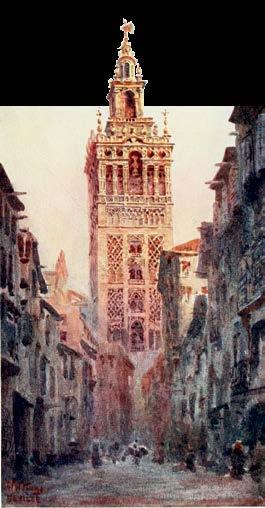
Collins fell in love with the life of the roofs of Sevilla.
“In early spring, before the great heat comes, and in autumn before the cold winds arrive […] Seville's washing hangs out to air, and up on the roofs, in the warm sun, with the hum of the streets far below, you will hear the quaint song—so Arabian in character—of the lavandera, as she pegs out the damp linen in rows.
“In the evening the clicka-click-click of the castanets and the sound of the
guitar, broken by merry laughter, tells one that perhaps the Sevillano has fathomed the mystery of knowing how best to live.” He made a number of sketches and paintings of Sevilla’s remarkable offerings, including the Alcazar and inside the Cathedral.
But it was the 12th century Giralda Tower (left) that stands out, the ‘magnificent relic of the Moslem's rule [that] rears its height far above everything else in Seville.’
Once the ‘greatest port in the world’, in the early 1900s Collins lamented: “Where are thy glories now, oh, Cadiz?”
Many would argue that the capital of tuna territory has recovered its former grace, although it remains some distance from being the world’s greatest port. Collins described it as ‘still a White City lying embosomed on a sea of emerald and topaz’.
Unfortunately, he noted, by the 20th century Sevilla had robbed her of trade, leaving her ‘little more than a port of call for American tourists.’ He produced two paintings in Cadiz; one of the cathedral (below) and another of the central marketplace - ‘a bustling scene, full of colour.’



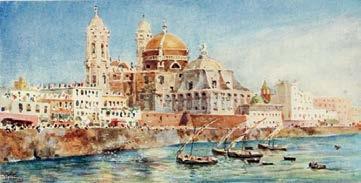
cordoba - second only to the great damascus
The first thing Collins noted upon his arrival in Cordoba a century ago was that, under seven hundred years of Christian rule, it had ‘dwindled down to what one finds it to-day—a quiet, partly ruinous town.’
“Of all its great buildings nothing remains to remind one of the past but the ruins of the Alcázar—now a prison, a portion of its walls, and the much mutilated Mesquita—the Cathedral.”
The Mesquita dazzled him most of all with its scale and size - Collins erroneously claims it is ‘the second largest church of any in existence.’
“Coming suddenly into the cool shade of its many pillared avenues, I felt as if transplanted into the silent depths of a great forest.
“In every direction I looked, the trunks of huge trees apparently rose upwards in ordered array.
“The light here and there filtered through gaps on to the red-tiled floor, which only made the deception greater by its resemblance to the needles of a pinewood or the dead leaves of autumn.
“Then the organ boomed out a note and the deep bass of a priest in the coro shattered the illusion.”


The Cordoba bridge was captured in his typical watercolour style, with its 16 arches and guarded at one end by a Moorish Tower, ‘round which the road passes instead of through a gateway, thus giving additional security to the defence.’


A third of Manilva’s residents are from UK - and here’s why

sea along a peaceful beach trail.
And then minutes later you could find yourself among rolling green hills populated by luxury villas, or burgeoning vineyards around a whitewashed village.
And on your journey you will meet a kaleidoscope of people from all walks of life, each with a story to tell.
Manilva officially has the highest percentage of Brits on the padron in Spain, with between a third and a quarter of the 18,000-strong municipality hailing from Blighty. But it’s not just Brits - foreign, set tled residents, many from northern European countries, make up


In spite of these high numbers, Manilva is not simply an expat colony - not
The district has a strong and thriving Spanish culture and community that lives extremely harmoniously and very cordially with their foreign guests.
The locals and the foreigners mix and mingle in the




same bars and restaurants and the pitter patter of conversation dances between English and Spanish - and very often halting Spanglish.
“We come here for the sangria,” Londoner Richie tells the Olive Press in the shade of a Spanish bar near El Castillo, a tiny fishing settlement buzzing with Spaniards and foreigners. “We go around to all the towns along the Costa del Sol,” his friend Siobhan adds. “We even go as far as Algeciras.
I give the sangrias in each place a score out of ten.”
And how much did she give the sangria in
El Castillo? “Oh, this is a nine,” she declares - nowhere gets a ten. “I think it’s the cinnamon. They get it just right.”
El Castillo gets its name from the castle that guards its sea walls. Built in 1767 by engineer Miguel del Castillo and builder Jose Vargas, it was financed by Sevilla businessman Francisco Paulino. The fortification was planned with war against the English in mind, with Gibraltar having fallen to the new-
ly-formed United Kingdom just half a century before.
In its more modern incarnation, as recently as the 1970s the monument was a residence divided into 16 homes for families housing 70 people.

Today it is a tourist attraction in an ideal location, but beware - it doesn’t open on weekends!
Just a short stroll along the beachfront from El Castillo, you will find a port unlike any other port on the Costa del Sol. Puerto de la Duquesa is the only one to face out to sea. From each of the three edges you can gaze out into the Mediterranean.
Duquesa is, without a doubt, the thriving coastal jewel in the Manilva crown, benefiting from tourism and buzzing with life.
For most of its history Manilva has been dependent on fishing and agriculture, especially its vineyards and celebrated sweet wines.
But over the last couple of decades, as this little township has welcomed an influx of tourists and development, it has still maintained a peaceful air.
Though the Brits and the 180-odd other nationalities come from all walks of life and occupations (Ed: some have even set up a newspaper here) they all have something in common.
Like Manilva’s first health tourist, Julius Caesar, who visited the nearby Roman baths around 60BC, it seems that people come here for a temperate life beneath the jaw-dropping mountains, fed by the fruits of the sea.
Bob and Jen from Essex told the Olive Press over Belgian fries that they manage to come to Manilva once a month

for as long as 10 days a pop.
But they are content with splitting their time in this way, and are not tempted to fully retire to the sun just yet.
Bob, who works in the solar energy business, still has a few more panels to lay in this booming industry before he’s ready to hang up his work belt. But it is partly due to content second-home expats such as Bob and Jen that the unpretentious Duquesa has undergone such a growth spurt in the last decade - and the expansion doesn’t look like slowing down anytime soon.
Aside from the fantastic prices of homes in the area, the environment is distinctly low rise, largely green and everything is close to the sea.
But when you do venture inland, you will head into wine-making territory. Manilva town, a sleepy, glittering village nestled on a hilltop, is famous for its sweet wine. It, and the process of making it, is something indelibly imprinted on the locals.
New cafes, bars and restaurants with cuisine from all over the world are springing up as a result of its growing tourism.




Even our taxi driver proselytised over the wonders of this wine - although he did advise us not to get through more than one bottle at a time.
When you arrive in the village, you will see that the central Plaza de la Vendimia (Wine harvest square) is adorned





with a spectacular mural depicting workers in vineyards.
And in the nearby interpretation Centre, opened in 2010, you can do vocational courses in wine-making, aimed at inspiring the younger generations and training future professionals.
The locals like to boast that the moscatel de Alejandria is the best table grape in the whole of Spain and that it is specific to Manilva, whose slopes have been continuously planted with vineyards since 1501.
The basic wine made from this grape - the Manilva wine - is known as ‘vino mosto’, and in the olden days, almost the entire town earned a living from it. The trucks would come from as far as Bilbao to take the grapes and whatever was left would be turned into wine.
Almost all of the locals that the Olive Press spoke to could remember back to those days.
Most of them had been living in Manilva village all their lives, they all knew each other, and they had done so since childhood.
“This place is one big family,” lifelong resident Eligio told us.
Eligio, who’s sun-beaten blue eyes twinkled as he regaled us with tales of Manilva over two cañitas that he generously bought for us, said he spent most of his free time in the village church.
Nearby, a sign displayed the village motto: Very noble, very loyal.
Then another man who had been listening in walked over to our table, put his hands on Eligio’s shoulders, and told us with all sincerity that our new friend embodied this motto.
It turned out that they had known each other since they were kneehigh, and Eligio had even worked for the man’s father.
Further along, and buried in Manilva’s historical heart a short walk from the centre, is St Anne’s church and adjoining cemetery, where Eligio liked to spend his time.
Who he was remembering he did not tell us.
Turn a corner and there the 250-year-old church is; striking yet simplistic, bold yet unassuming.
Sauntering through the maze of white houses with their terracotta roofs, every ‘Hola’ from passers-by strengthens the feeling that Manilva is very much Spanish still. Up on the mountain it is removed from the wave of tourism lapping at the coast. And then there are the postcard views from every direction, white houses spill down into vast vineyards with mountains out behind and the Costa del Sol to the front.
The Pedreta viewpoint delivers a view stretching from the white cluster that is the mountain-clinging Casares village to the
coastal hubs of Estepona and Marbella below. A rich network of tracks is visible in between, inviting you out to hike, cycle or horse-ride.
Our commitment to you is to give a patient-centric approach

Another short walk and a hop and you are down in San Luis de Sabinillas, or just ‘Sabby’ as it is affectionately known to the expats.
Like everywhere else on the coast, it too has flourished under tourism in the last decade. But there remains a tangible working atmosphere (it still has a small fishing fleet) and this is still a town where Spanish people enjoy their Spanish lives.
A coastal stroll from Puerto Duquesa, Sabinillas has also become a popular destination for expats.


It is certainly a distinct community with a healthy mix of Spanish, expat English, German, as well as Moroccans and South Americans. It is also a veritable hive of commerce. While it wins no beauty awards, there is a great range of supermarkets and shops in Sabinillas.
‘Wall Street’ is where traditionally all the banks and insurance companies centred and down on the beach there is a great range of bars and restaurants which stretch into the distance on either side.
Back on the blue flag beach, that stretches all the way from Rio Manilva to Puerto Duquesa, fishermen still launch their boats and are often met by waiting restaurateurs upon their return, eagerly awaiting the days catch.
Sabinillas effectively bridges the gap between the multi-cultural, tourism-driven hub of Puerto Duquesa and the withdrawn, tranquil, traditional village of Manilva.
With the right blend of coastal expansion and Spanish tradition, it is easy to see why Manilva is making a name for more than just its wine.

WE understand that each person is unique, and so are their hearing needs. We conduct thorough exhaustive assessments to comprehend the nuances of each case, ensuring we provide solutions that perfectly tailor to individual needs.
The rapid evolution of hearing technology demands staying at the forefront of the latest innovations. Our continuous updates enable us to offer cutting-edge, personalised solutions to each of our patients, from smart hearing aids to advanced connectivity devices.
We acknowledge that hearing care goes beyond merely selling a hearing aid. We accompany our patients at every step of their journey towards complete auditory rehabilitation. We maintain a close bond, providing continuous support throughout the entire process.
We set our prices fairly, without hidden costs or unpleasant surprises. We offer high-quality products at competitive market prices. We want our patients to feel confident that they are receiving exceptional value for their money.
Audiosanit Hearing Clinic means opting for technical excellence, a patient-centric approach, and the most innovative technology at an exceptional price.
+34 722 312 193
www.audiosanit.es
info@audiosanit.es






Open:
Monday to Friday: 10.00 - 18.30h
Saturday: 11.00 - 13.30h
T: 952 892 992
EMERGENCY: 691 071 770
info@mediterraneavets.com
Mediterranea Vet Practice


EVERY September Manilva celebrates its winemaking tradition in a three day harvest festival, with flamenco dancers, brass bands, music and dancing into the early hours in the Plaza de la Vendimia.
The sweet moscatel grapes have been grown in the vast vineyards that surround Manilva since the 16th century and are used to make the aptly named Manilva wine, famous throughout Spain.
Although vines have been grown on the sunny slopes of the town for hundreds, if not thousands, of years, it is fairly recently that wine became one of the area’s main products.
Winemaking became the town’s main economic activity after the Spanish Civil War because of its ideally suited climate and soil.

of the local calendar, drawing visitors from across the region to see the winemaking process.
As well as making the sweet dessert wine, the moscatel grapes are also dried on the hillsides to make the famous ‘Malaga raisins’.
The festival was founded in the early 1960s and has become an important part Malaga.
The festival has even been declared of Tourist Interest by the Provincial Council of
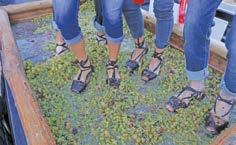
During the celebration of the end of the grape harvest, the very first wines produced are presented with tastings handed out of the sweet wine.
In the early hours of the morning, a Rocio Mass
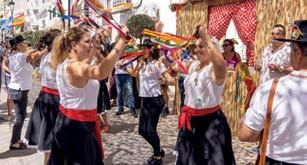



through the village streets. This procession is accompanied by local young women dressed as traditional villagers, who pray for the fields of Manilva to be protected.
In Manilva, it is still customary to step on the grapes for hours on a square surface with a protruding edge and a slight tilt towards the centre of either side. It is through this point that the juice, or must, flows into a wellshaped tank on a lower level.
Every year, a resident is honoured to be in charge of treading this fruit. The crowds gather on Calle Mar to witness the grape treading and taste the first wine of the season.
IF you are lucky enough to dine at the swish Basque Restaurante Martin Berasategui – which has three Michelin stars – order a bottle of Nilva from Manilva. Produced from moscatel grapes grown on a tiny vineyard overlooking the sea, the dry fruity white made a big impression on the 12-Michelin-starred chef, Berasategui, who personally selected it for his wine list.
Also, the classic wine Nilva has been officially 'the best white wine' of the province, thanks to having won the annual Sabor a Malaga competition. This success would be remarkable by any standards but the fact that Nilva is the realisation of one Albacete man’s dream makes it all the more astonishing.
When I ask Argimiro Martinez Moreno how many people he employs to make the wine, his answer is simple: “One, including himself!”
Not long ago the local wine came in a plastic bottle with no label.
Wine from Manilva vineyard makes it onto the wine list of one of the world’s best restaurants, writes Elena Goçmen Rueda
(grape harvest and festivities) Tours take place in Spanish, English or French, but Argimiro says he happily caters for groups of other nationalities.
“And it’s important that local establishments serve up local produce, especially since Brits and Scandinavians love dry, fruity wine and have given great feedback.”
The Manilva vineyards are at the heart of a massive project to boost local tourism.
Argimiro also runs the wine museum and ‘wine interpretation centre’ at the entrance to Manilva, a treasure trove of exhibits,
Now Argimiro is leading a battle to revive and promote local winemaking which, after all, has been going on since Roman times. Several restaurants and bars along the coast have stocked the delicious wine, but there should be far more.

with audiovisual rooms showing educational films, a chance to see wine being made, and local art exhibitions which change monthly. Guided tours of some two hours must always be booked in advance and cost around €25 per person.
The visit begins by reviewing the wine history of Manilva, viewing a video and touring the three different rooms: Viticulture, local winemaking and Vendimia
The impressive museum building, which boasts an underground bodega and lab, huge auditorium, bar and terrace, was built by the town hall in 2008 and used for two years as a wine school (Argimiro was originally a teacher) for 24 lucky students until the Junta ran out of funds.
Now he is convinced that the town can cash in on the estimated six million people coming to Spain for wine tourism each year.
“I believe we can attract a new cultured crowd to Manilva, aside from the traditional beach tourism,” he says.
More than just a tourist attraction, the museum’s purpose is to inform locals as well as visitors about the area’s long-standing winemaking tradition. And also the need to protect it.
Maps and guides prove that some 500 years ago Manilva was covered in vines, but since then nearly three quarters have vanished, most of them in the last two decades due to development.
“Ultimately owners made a lot more money selling their land to developers than from making wine,” he explains. “Perhaps 30 to 40 times that amount.”
Some of the most productive vineyards, such as around Dona Julia golf course in Casares, have long gone due to the construction boom.
One of Spain’s most infamous developers Rafael Gomez Sanchez, aka Sandokan, allegedly bought up around half of the land surrounding Manilva village and it was only the property crash that stopped him digging up the lot.
“I am passionate about protecting the vines,” says Argimiro, who is now lobbying the authorities to protect the vineyards and help give them new life.
An agricultural engineer by trade, he moved his family to Estepona in 2009 and rented the vineyard

WINE MAN: Argimiro is a one man show
‘del Penoncillo’ from the town hall for €15,000 a year, including the use of the bodega and museum.
“It certainly hasn’t been easy,” admits Argimiro, who currently bottles between 2,500 and 5,000 bottles a year depending on the harvest.
It’s hard not to admire this man for uprooting his life in Albacete to bring his wife, Inma, and kids Argimiro and Carlos with him on his wine crusade. He was raised by a father who made wine as a hobby, so the passion for winemaking is almost genetic.

And his agricultural engineering degree, which he got in Cordoba,
led to designing vineyards and other projects.
Now his key goal is to get more international chefs, like Martin Berasategui, to visit the winery and stock his wines.
He had first met Berasategui in San Sebastian in 2015 after sending him some samples to try. “He has since completely backed our vision, sponsored some vines and is planning to visit in the future to continue supporting our vision.”
If you don’t have the budget to sample Nilva along with a threecourse dinner at Restaurante Martin Berasategui, you can buy a bottle from the museum in Manilva where it sells from €12.50. An organic variety of the wine is also sold in the shop, which sells for €15. If you prefer to buy it online, the Nilva Eco sells for €16.50, leaving the classic Nilva at €15.
You never know, the local restaurants nearby might let you open it with lunch.




Once upon a time Manilva was among the richest and bestconnected places in the world
THE legacy of the Roman Empire permeates throughout the Iberian Peninsula, not least on the Costa de Sol which acted as the gateway to the Mediterranean.
The Romans’ love affair with the Costa del Sol was not hard to under stand.


Apart from the climate, bountiful fishing and rich pastureland, the area was a vital corridor to the Em pire’s first line of defence. Manilva and Sabanillas thrived as Roman towns, evidenced by the many ruins that you can still see here today, such as the Roman baths, believed to have been frequented by Julius Caesar's army and the Ciudad Romana de Lacipo, an ancient Roman outpost just north of Manilva.
First, a little history … Baetica, the Roman name for Andalucia, became one of the most dynamic and economical-


ly developed regions in the farflung Roman Empire, rich in resources and modern in outlook, even welcoming liberated slaves. Before the legions arrived in the second century AD life was hard and simple, the land dotted with small and isolated agricultural settlements. However the development of a fish salting industry fuelled by increasing Roman presence on the Iberian Peninsula saw most of these segmented populations moving to the coast, settling in the town we now call San Luis de Sabinillas.
At that time, salt curing was the best method for preserving fish for export by sea to Rome and other parts of the Empire. Manilva became known as Saltum and came under the administration of Conventus Gaditanus - a vast region stretching from modern-day Cadiz province and along the the entire Costa del Sol to Almeria. Casares, under the Roman name of Lacipo, was a strategic gateway from the valley to the mountains of Cadiz and Malaga. Manilva and Casares boasted road links as good as EU funding has provided today. They were connected by one of Baetica’s main thoroughfares to Carteia
Julius Caesar himself is said to have cured a skin complaint in the spring
(currently San Roque where the Roman ruins of Carteia still partially survive), Corduva (now Cordoba) and the city of Baetica, together with Italica and Hispalis, both in the Sevilla region. Some of that amazing infrastructure still survives. Roman remains can be found in Sabinillas, Haza del Casareño, Lagunetas, Manilva and Castillo de la Duquesa which showcases the remnants of a Roman Baths, town, curing factory and even a necropolis. Protected as an Asset of Cultural Interest, the ruins can be visited today and undoubtedly the most popular ‘asset’ is La Hedionda, the Roman baths built around a natural mineral spring where Julius Caesar himself is said to have cured a skin complaint. Still in working order today, the name means Stinky in Spanish and comes from the sulphurous waters which smell like rotten eggs. The good times ended when Baetica was invaded by Visigoths and the Roman’s Iberian empire fell around 5AD. People started to abandon the coastal settlements, returning inland in search of other ways to survive, perchance to dream of the glory that was once Rome.


● 6,000 BC - Neolithic farmers arrived in Manilva, leaving stone tools and pots in places like the Sierra de la Utrera caves, just north of Sabinillas.
● 1,500 BC - The Phoenician civilisation spread across the Mediterranean, leading to settle- ments in Cadiz (meaning ‘fort’ in Phoenician) and the Castillejos de Alcorrín settlement in Manilva.
● 200 BC - The Romans invaded the Iberian pe- ninsula in 206 BC, esta- blishing a fishing village in Manilva. Julius Cae- sar became governor of Southern Spain in 61 BC and is believed to have cured a skin disease in the Roman baths at Hedionda.
● 711 AD - The Moors invaded the Iberian penin- sula and established the settlement of Martagina just south of La Chullera.
● 1400-1500 AD - Barbary pirate raids forced most of the population to flee into the hills for security. However, many still returned daily to fish.
● 1515-20 - Following the Reconquista, the Duke of Arcos conceded land in present-day Manilva to the fortified town of Ca- sares for growing grape- vines.
● 1530 - The hilltop village of Manilva proper began to take shape thanks to its Duke, who parcelled off pieces of land to en- courage people to settle there.
● 1722 - The Church of Santa Ana in Manilva village was destroyed by an earthquake.
● 1796 - Manilva gained independence from Ca- sares, when it was given a ‘royal privilege of the town’.
BUSTLING Duquesa marina is cut off from the mainland by a whitewashed shell of intricate buildings, balconies, plazas and steps, like an oyster enclosing its pearl.
The back end of the port is lined with imposing Chinese restaurants, immaculate in appearance; they are the back-
bone of this multi-cultural hub.
A walk around the port, which scarcely takes longer than five minutes, reveals cuisine from all over the world.
As well as restaurants serving cuisine from across Asia-China, India, Japan and Singapore,
there is a plethora of European options.
It could be argued that Duquesa lacks Spanish identity as there are more English voices than yachts and more burgers than tapas. But by taking a step out either
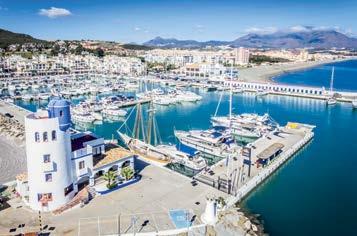
side of the port, the expansive soft sand beaches will firmly remind you where you are.
This meeting point of friends and cultures sings through its restaurants, cafes, bars, the people who work in them and the people who sit in the sun and enjoy them.
And Duquesa is, more than anything, likeable, as if it were Puerto Banus’ younger, more relatable and friendly sibling. This sociable spirit emanates not only from tourists and expats but the staff, who hail from all over the world including Latin America, Eastern Europe and Asia.
Puerto Banus may win in terms of glamour but Duquesa is more affable and, importantly, much more affordable.
It is still very much a 21st century place too, with wifi freely available in all the cafes and every possible amenity a short distance away. But Duquesa doesn’t feel like it has been ruined by tourism or de-Spained by its growth.
The wonderful variety on offer in such a small enclosed place shows this port is precisely designed to be quirky, eclectic and affordable.



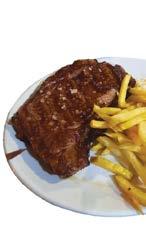


The Manilva Equipo de Gobierno presents its new midibus for public transport services with another to come
WITH great anticipation, Manilva Equipo de Gobierno has revealed its new midibus, completing the local transport service.
The bus is a joint project with municipal parish priest José Antonio Melgar.
The Ayuntamiento de Manilva, through Alcaldia and Parque Movil has achieved the acquisition of this new 30-seater midibus in record time, which will be available for use immediately.
The Mayor of Manilva, José Manuel Fernández, has highlighted, on behalf of his team, the great work that has been done and that will benefit local citizens to greatly improve local transport. The distinctive livery, which will give identity to transport in our town, will also be used on all taxis.
It should be noted that we are working on another bus, with 41 seats, which may be operational around October.




The Englishman found Granada and its location on the edge of a fertile plain at the base of the Sierra Nevada to be perhaps his most agreeable. He discovered ‘tortuous streets which wind up the steep hill sides’ and marvelled at ‘the life of an ordinary Spanish town’ in the springtime.
The Alhambra, which he calls the most fascinating spot in all Spain, rises above the city and ‘broods over past glories of the civilised
Moor’.
“How is it possible to describe the Alhambra?” he asks.
Before the location had been turned into a UNESCO heritage site through which three million people trampled each year, Collins set foot through the ‘massive doors.’
Here he produced a sketch of the Court of the Lions - ‘so called from the central fountain upheld by marble representations of the kingly beast, surrounded by a beautiful arcade.’


Malaga was Cadiz’s rival for the title of oldest seaport in Spain, but Collins was clear that it was definitely ‘the noisiest town in Spain’ at the start of the 20th century.
Although every city in Andalucia was ‘a babel of street-cries’, Malaga was just a little more so than all the rest.
“The seranos, or night-watchmen, disturb one’s rest as they call out the hour of the night, or whistle at the street corners to their comrades,” he writes, while ‘a breeze makes hideous the hours of darkness by the banging to and fro of unsecured shutters.’
While sketching from the harbour, he described the scene as ‘an impressive fabric with all its
architectural incongruities.’ “So it struck me as I sat on the quayside of the Malagueta making my sketch, sadly interfered with by an unpleasant throng of idling loafers.” He bade farewell to Malaga by serenading the ‘delightful climate despite the fierce winds and the dust they raise.
“Though rain seldom falls the cool sea breezes in summer bring a refreshing tonic to the dweller up country.”
Collins also hinted at Malaga’s touristic future, observing that ‘many Spaniards at this season come here for bathing, and obtain a maximum of sunshine without the intense heat of the interior.’
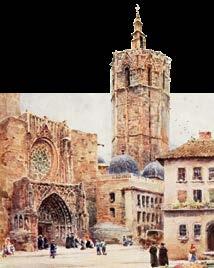
Collins wrote that the road that connected the city of Valencia to its port was the ‘busiest high road I saw in Spain.’
“Strings of laden donkeys, waggonettes crammed with good-humoured laughing fisher[men] and country folk pass along, an electric tram carries those who can afford the extra centimos, and the carriages of Valencia’s well-to-do citizens take them to the harbour for a breath of sea air out on the breakwaters.”
Once again echoing the Spanish costa’s visitor-friendly future, he noted that the wines were so cheap that it was more expensive to drink water, but with one key difference - ‘drunkenness is unknown’.
The local peasantry were ‘very illiterate and scrupulously honest’ and ‘like the Andalucian, he is absolutely trustworthy in all his dealings, which are conducted by word of mouth’.
There was just one lawyer in Valencia to the 10 further north, ‘where modern ways of life are more in vogue’. He settled down to paint his customer watercolour of Valencia’s cathedral (above), although he was hardly impressed.
“The Cathedral was originally a Gothic structure, but one fashion following another, has been at different times so altered and robbed of all architectural beauty that there remains but little of interest in the building.”


Go local and taste the difference, says Christin Hagemeier
THE arrival of Spring brings a vibrant transformation to the world around us.
The once barren landscapes now burst with lush greenery, as flowers unfurl and display their vibrant colours and the first fresh fruits are ripening.
There was once an undeniable joy that came from indulging in the produce that had grown right on our doorstep or just a stone’s throw away and which filled our local markets. Times have changed and we do not have to wait for the first crops of the year.
Supermarket shelves have been laden with fruit and vegetables all winter long. On the one hand, we can say: “Luckily, we can afford such luxury!”
On the other hand, we forget so many wonderful fruit and vegetables which contribute to the diversity and variety of nature’s products, because they are maybe not as easy to cook, or they are just not fashionable.
To give us access to ‘all-time-favorite-products’ at any time of the year supermarkets ship groceries from all over the world to us in Europe.
This causes a lot of environmental pollution as they need to be kept chilled,
which needs energy.

And this is usually provided by fossil fuels, which then release CO2 into the atmosphere.
The other option is to grow everything in greenhouses, which need to be heated during the winter - this too is not an environmentally friendly option.
The Spanish government publishes a table Calendario de Frutas y Hortalizas de Temporada to give people guidance on which fruits and vegetables are seasonal and regional in Spain.
Furthermore, there are more wonderful guides on the internet, like soydetemporada. es, which makes it even easier to see which products are now growing right on our doorstep.
And, believe me, these fruits and vegetables are even tastier as they have been allowed to ripen naturally rather than be picked unripe to allow for transporting.
Don’t limit the variety on your plate by cooking and eating the same, convenient vegetables. If you open your eyes, you will see what a variety nature offers to us and how tasty vegetables are on their own - when grown locally and bought in season.


RESERVOIRS in Malaga are only 24% full despite days of rain, prompting government officials to extend their call for ‘responsible water usage’ as drought continues. While Storm Nelson forced a number of Easter celebrations to be called off, many believers thanked God for the downpour.
Malaga’s seven reservoirs have gained 31.34 hectometres, taking them from an average of 18 to 24% full. La Concepcion, which supplies water to the west coast,


has gained 11.28 hectometres and now stands at 55% capacity. Meanwhile, La Viñuela has gone up 10 hectometres and is now 16% full.
GREENPEACE has issued a stark warning that up to 75% of Spain could be at risk of desertification without urgent action to reverse the effects of climate change. The worrying figure, which comes from research carried out by the UN Convention to Combat Desertification, reflects the ‘critical’ water situation in Spain. Desertification is the process by which vegetation in drylands decreases and eventually disappears, creating a desert landscape. According to Greenpeace, which released the information to mark World Water Day, celebrated on March 22 every year, Spain and Greece are the European countries with the greatest stress placed on water supply.
Over 12 million Spaniards are currently under some form of water restriction, with droughts raging in Andalucia and Catalunya as reservoir levels continue to dwindle.


The reservoir supplies the Axarquia area, where locals have been dealing with a serious drought since the start of the year.
At one point, it reached a 7% low.
The latest reported figures for each reservoir, as of Monday, April 1, are as follows: La Concepcion (54.51%), Casasola (29%), El Limonero (20.5%), La Viñuela (16%), Guadalteba (22.4%), Guadalhorce (17%), Conde de Guadalhorce (30.6%).
Altogether, Malaga’s reservoirs are 81 hm³ behind last year’s 225hm³.
As a result, local leaders are still urging ‘prudence and responsibility’ when it comes to water use and many water saving measures remain in place.
The Junta highlighted it would take at least three episodes of rain like those seen in Semana Santa to recuperate the reservoir levels seen at this time last year.

Readers give their advice and reactions to two recent stories in the Olive Press
WITH regards to your article Ruff Justice concerning Stephen Hill who was bitten by a dog in Marbella and said he could not make an official police report.
I was surprised it said the Guardia Civil were contacted as the area where it happened is within the jurisdiction of the National Police, who would therefore be tasked with the investigation.
In Spain anyone wishing to report a crime which involves any injury, must at the time of mak-
ing the allegation (denuncia) to police, produce a medical report confirming the injury.
Even though the incident happened on a public holiday, the victim could have obtained a medical report from the urgencias department of the Costa del Sol Hospital or a private medical facility.
Mr Hill returned to the UK the following day.
One is able to make a report in the UK of a crime which occurred outside the UK.
The police will forward it via INTERPOL, the police liaison arrangement, to Spain, or in fact any country which has access to INTERPOL.
Note the UK police may take a bit of ‘persuading’ but they do have the power to do so!
Regarding the article about a cat killed by two hunting dogs which had managed to get into his house (Olive Press Costa Blanca North) I must highlight that the Spanish police are covered by EU juristic regulations.

When the police attended they told the owner there was nothing to do as ‘it was only a cat’. This matter is of a most fundamental issue: respect for everyone's property, including damaged doors and, above all, the animal which belonged to a person. It could be any type of creature - even a fly or lizard. It is still proper-
ty. Possessing aggressive dogs must be treated in the same way as possessing a gun, or anything which could endanger life or health of everything around - animals or humans. It is absolutely the responsibility of the dogs’ owner to keep full control of them. In this case, the owner of the two hunting dogs must be taken to court as he clearly failed to do so. What if it was a child or a vulnerable person? This point is the very bottom line. Such incidents must not be swept under the carpet.
Dr Jakub S MalinowskiKnowler (by email)

HAVING finished construction of our property in Spain in 2010 we and my parents have had regularly holidays in Mijas over the years
As you know since Brexit our access to our home in Spain has been curtailed to 90 days in every 180 day rolling period.
For various reasons we don’t want Spanish residency, but the golden visa would be an option. Unfortunately, our property was completed in 2010 and the cut off date is 2013, so I am told this is not possible.
We had a meeting with the lawyer and accountant that represents us but it would cost us over €170,000 to sell and then buy it back, and that cost can’t be justified.
We feel that our European Civil Rights have been broken. We built our house in Spain and our rights to visit our own property when we want has been removed.
We feel that if a property was owned prior to Brexit, no matter when it was built or bought, then the current valuation of that property should be used to gain a golden visa or even a simple homeowner visa should have been an option.
Skea (by email)

SPAIN'S biggest telecoms merger has become a reality, with Orange and MasMovil completing the legal process to become a joint company.
The two operators will have a base of over 30 million mobile phone customers and will become the leading telecoms firm in the country, based on client numbers.
The new entity - which has yet to reveal its namealso has over seven million broadband subscribers (fibre and ADSL) and another two million who access television services.

LIVE music concerts and festivals in Spain during 2023 reported a 26% increase in turnover to nearly €579 million.
The figures come from the Association of Music Promoters (APM).
It says that Spain’s live music industry has beaten the previous record of €459 million recorded in 2022 and has
By Alex Trelinskibeen constantly growing since 2014, with the exception of the Covid pandemic years. APM president, Albert Salmeron, said: “We don't think there is a bubble and we think on the contrary that there is still a long way to go.

AIRCRAFT manufacturer Boeing has paid out an undisclosed sum to settle a lawsuit after a Spanair plane crashed in August 2008 with 154 people losing their lives.
Flight 5022 crashed on takeoff at Madrid airport as it was departing for Gran Canaria.
The aircraft involved in the crash was a McDonnell Douglas MD-82, with Boeing having acquired the manufacturer in 1997.
The lawsuit claimed that Boeing ‘was
“Live music has become a form of leisure and access to culture that has become even more popular compared to 10 years ago and the sector evolves organically and progressively year after year."
The APM revealed that the Arenal Sound festival in Burriana (Castel-
aware of a mechanical defect that increased the risk of error during takeoff but failed to apply a known fix to all of their planes’.
Initial reports suggested that the plane’s flaps and slats had been incorrectly configured for take-off, and further investigation revealed that the aircraft's take-off warning system had not sounded.

lon) was the highest-grossing festival last year, bringing together 300,000 people over six days.
Second was Primavera Sound Barcelona (243,000 in five

AFTERMATH: 154 people died
days) and Viña Rock, in the Albacete province town of Villarobledo (240,000 in four days).
By region, ticket sales were the highest in Madrid, Andalucia and, especially Catalunya, which hosted many stadium concerts featuring big names like Coldplay, Bruce Springsteen and Beyonce - accounting for 26.35% of the national turnover.
Coldplay alone pulled in over 221,000 spectators for their four Spanish gigs. Albert Salmeron said: “Last year was unique, because so many tours built up after the pandemic break and we thought that there could still be a drop in ticket sales, but it wasn't like that.”
GAMBLING has soared among young people in Spain since the Covid pandemic, according to the Directorate-General for the Regulation of Gambling
The number of people aged between 18 and 25 years having a flutter has risen by 41% since 2019.
The average amount of bets has also gone up from €215 per year in 2019 to €333 in 2023.
The study says the 18-25 age group was very close last year to being the main age range for gambling, only surpassed by those aged 26-35, which has seen a 12% rise since 2019.
Extra time at home combined with the proliferation of gambling phone apps during the Covid pandemic are said to be responsible for the upward trend.
The four main gambling areas are virtual versions of betting, bingo, poker and casino. The survey reveals the most popular category is online betting on sports events and mobile games.






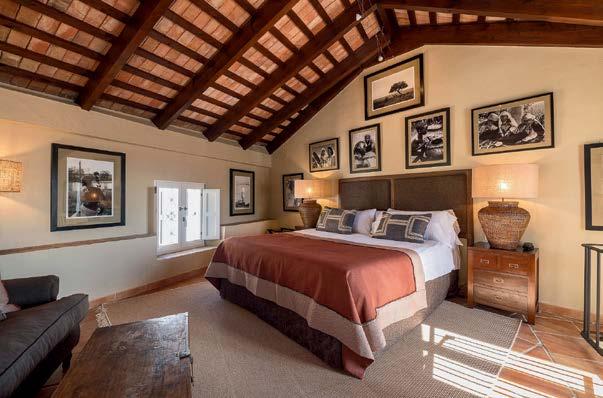
THE price of chocolate in Spain is going up due to the ever-increasing cost of cocoa.
Cocoa now fetches over 10,000 US dol lars per ton, compared to around 2,900 a year ago.

Boss of Alicante producer, Valor, Pedro Lopez, said: "The chocolate market is going to suffer a lot and it's going to lead to unavoidable increases."
Poor harvests, mainly in Africa, which accounts for 70% of the world's production, are the main problem. Much of the crop disappeared under heavy rains and raised the price of cocoa by 27%.

WORRIED: Pedro Lopez
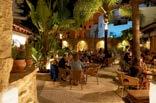
Hotels • Homes • Restaurants • Hammam



+34 956 447 730 califavejer.com
Plaza de España 16, Vejer de la Frontera
A SPANISH startup company is growing hops indoors under multicolour LED lights to ensure that climate change doesn’t halt beer production.

Open everyday 12:00 - 22:00
The best chicken and ribs in town also available
salads, fries, garlic bread, wraps and kids menu





Ekonoke says the hydroponically grown hops will shield beer from the impact of climate change, as hop plants don’t like the hotter, drier conditions experienced in recent years, resulting in production falls.
Hops are a key ingredient in beer making, combining bitterness and complex aromas. But the plants are very demanding when it comes to growing conditions - they
CONTROL: Hops are being grown indoors
require an abundance of water, fresh temperatures and good light levels, and are only happy within certain world latitudes (between 42 and 45 degrees).
In Spain, hops are mostly produced in one northern region, Castilla y Leon, where farmers are struggling with a multi-year drought.
According to the compa-
BUDGET train company Ouigo is hopefully set to launch in Andalucia, Murcia and Valladolid, sending costs plummeting around the country.
In June, the French high speed train operator will set up new stops on its Madrid-Valencia line.
Later that month, it will expand its network in Eastern Spain, with destinations in Elche and Murcia, linking up this line with Valladolid on its way to Madrid.
In the second half of the year, it will launch lines connecting Madrid and Andalucia including Sevilla, Malaga and Cordoba.
Tickets will start at just €9 for adults, a price so low that Spanish transport minister, Oscar Puente has accused the company of ‘flagrantly plummeting prices.’
A RESPECTED food publication has named these four Malaga restaurants amongst the best in Spain roadside stops.
According to El Comidista, Caserio San Benito, La Butibamba, Florida Beach Mijas and Chiringuito Sonora Beach offer up ‘first class’ food to hungry travellers.
Caserio San Benito, near Alameda, was highlighted for its ‘marvellous’ pinto bean stew.
Meanwhile, the publication highlighted two venues in La Cala de Mijas.
La Butibamba was recommended for its Coin pork, and Florida Beach Mijas, for its ‘excellent’ rice dishes.
Finally in Estepona, Chiringuita Sonora Beach was praised for its relaxed vibe and salmorejo potatoes.
ny, extreme weather events linked to climate change are reducing the productivity per hectare of hops outdoors by up to 30% and threatening the production of beer.
Its business model relies on entering 20-year contracts with beermakers, which involve setting up a hop-growing facility right next to their breweries.
All of Ekonoke’s production is being sold to Corporacion Hijos de Rivera, the makers of Estrella Galicia beerwhich already sells IPA and amber lager beers made with the startup’s hops. Ekonoke built a 1,200 square-metre pilot production facility next to Estrella Galicia’s plant in the northwest province of Lugo, on land rented to them by Hijos de Rivera.
Being much bigger companies, the brewers can negotiate better deals for construction materials and energy supply, considerably reducing the startup’s costs.

BEST: Caserio and Sonora

The hottest new joint in Marbella this Spring is
REFLECTING the warmth and colour of the Cyclades islands, it will be the first Greek-Mediterranean restaurant of its kind in Spain.
GAIA Marbella promises to be ‘a journey of discovery’ for anyone interested in learning about the best of Greek cuisine.
Launched at the Puente Romano hotel, it will be modeled on its successful sister restaurants in London’s ritzy Mayfair, Dubai and Monte Carlo. With limestone walls, classic Greek blue furnishings and splashes of magenta blooms, diners will be transported quickly into the world of Captain Corelli.
Thanks to the culinary skills of Evgeny Kuzin and chefs Izu Ani and Orestis Kotefas, it promises to be a true ‘dining experience’.
Now open, dishes include Orzo seafood pasta and oven-roasted baby goat as well as a ‘signature Seafood Market’.
“Bringing GAIA to Andalucia is so exciting for me,” explained Ani. “Southern Spain has such a rich gastronomic culture, with remarkable Mediterranean produce from the mountains and sea.”
In the spirit of Greek mythology, GAIA is named after the goddess who embodies the birth of life and the harmony of nature.
“The partnership with Puente Romano marks the fifth GAIA opening and

aligns perfectly, highlighting elevated concepts in the hospitality industry,” explained Evgeny Kuzin, Chairman of Fundamental Hospitality.
The GAIA experience will continue next door, meanwhile, with NYX, a signature speakeasy-style lounge concealed behind a discreet hidden door.
And that’s not all. This Spring the luxu-

ry beach resort on Marbella’s Golden Mile is also launching two other new joints.
The second, Chanca by Coya (below), will follow in the footsteps of the highly-successful Peruvian restaurant Coya, which opened at the Puente Romano last year. It will take guests on an ‘immersive


journey from late evening to early morning’, offering a fusion of continental cuisine and vibrant South American flavours. There will be live performances and



Candela Marbella, a restaurant right in the heart of the charming old town.
Enjoy traditional local and national dishes with unique international touches and flavours thanks to our chefs
Andi Zillner and Mathias Theodosis.
tel: 646 88 84 31 candelamarbella.com
Pl. Gral. Chinchilla, 2, 29601 Marbella, Málaga


curated DJ sets over dinner, which will go on to the early hours with ‘limitless beats and vibrant energy’.
“When the night calls for an atmosphere of chic sophistication, we will provide it,” explains Yannis Stanisiere, Global COO of Coya.
As revealed in the Olive Press in January, Malaga’s most famous restaurant Pimpi, is also to expand into the Puente Romano hotel this Spring.
The icon - part owned by Hollywood star Antonio Banderas - is to transport its unique character as a historic winery and place to eat to the heart of the hotel.
It took its name from the ‘pimps’ who used to direct foreign sailors from Malaga’s port into an area to find women.
It first opened in 1971 and it is the first time it has expanded since then.



And what about a dream day out with a gourmet lunch on Candela’s stunning new yacht?
“A choice of four distinct menus, one vegan, perfect for a fun - or romantic - day out on the high seas!”

But you can avoid the €3,000 wines and eat incredibly well and cheaply at Malaga’s best fish restaurant, writes Jon Clarke
IT has just been voted the third best ‘casual restaurant’ in Europe by US foodie website Opinionated about Dining. Yet, most locals in Fuengirola would struggle to guess which joint it was referring to.
But, the moment you step into Los Marinos Jose you know you are in the hands of professionals.
Just re-opened after a stylish refit, it has the sort of swagger found up the coast at Campero, in Barbate, or Aponiente, in El Puerto de Santa Maria.


We can thank the ambitions of owner Jose Sanchez for this… a man on a mission, who conveniently (for a seafood

The emphasis is therefore on super-fresh, daily-caught fish (not coincidentally all landed from his boat) and none of that factory-farmed stuff, but genuine bona fide morning-netted specimens.
That is obvious from the morning’s catch displayed on the bar - and backed up the second it hits the taste buds.
The menu is incredibly

THERE is a new secret gem in the heart of Fuengirola.
Hierro Casa de Fuegos is an Argentini an joint run by owner and chef Santiago Lambardi, who’S got cuisine coursing through his veins. On a recent visit we were welcomed by homemade signature cocktails

UNBEATABLE:
- with and without alcohol - with a typical Argentinian treat of roasted peanuts and chilli honey, the perfect balance to the acidity of my pisco sour.
The ethos of Santiago is simple: Use high quality ingredients, sourced as locally as possible and mixed with good old-fashioned cooking skills.
Take his homemade beef empanadas, served with a wonderful shredded tomato and coriander salsa. They were melt-in-the-mouth delights with not a hint of oil on the plate.
If the homemade bread with lemon zest and black pepper butter was good, the next dish of braised carrots
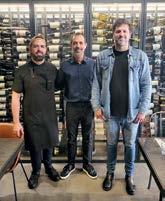
smoked with poached egg and homemade aioli rocked. A veggie’s dream, as was the cauliflower finished on the grill with almonds and fresh oregano. The sweetbreads, I must admit, were something of a departure to me. While I’m always wary of things like offal and in this case - the neck glands of a cow - they were perfectly cooked and, in the end, hardly touched the sides. And then, of course, came the steak, it being an Argentinian joint. A stunning well-aged
Being both the owner and head chef bodes well for Santiago Lambardi at Hierro Casa de Fuegos, writes Matt Jones simple, apart from the wine list (more of which later). Most things are served by weight and - given it’s all about what’s available at a fair price from nearby - there are, at most, two dozen dishes to choose from. And if you
It’s all about what’s available at a fair price from nearby
don’t like fish, don’t bother. We chose three starters and one main course, with a ‘busano’ (meaning sea snail) as an appetizer and perhaps the most bizarre seafood I’ve ever tried, even odder than barnacles (or ‘percebes’, as they call them in Spain).
It was from Marbella, after all.
The small clams were difficult to differentiate from other places on the coast, but the red mullet sashimi was a step above. Served thinly sliced it was then braised for 60 seconds by a waiter at the table with a culinary torch and in a word ‘awesome’. Next up were grilled small squids beau-


tifully presented and clearly hoiked out of the sea that morning. For a main we could have chosen turbot, sea bass or sea bream, plus a couple of others, but Jose insisted we went for the better value ‘borriquete’ from Conil, on the Costa de la Luz. Good call, it was de-boned and grilled to a tee, served with fresh new potatoes and green peppers.

Rib Eye from the celebrated Pampas, which roll west from Buenos Aires. The yellow fat marbled through the meat showed just how healthily our cow had lived, free range and grass-fed for its entire life.
I like my meat rare, although if you would like to cook it more at your table there is an option of having a hot stone.
Served with eggplant and ginger, Jalapeño peppers and honey, it’s hard to improve this dish.
Finally we tried a special green pasta called Agnolotti, which comes stuffed with pear and goats cheese. Wow. And then we had a dessert and one

amazing
to beat all desserts, death by dulce de leche, explained Santiago. Why not we thought to ourselves.
“The best things in life are steak, dulce de leche and Lional Messi,” Santiago insisted. “Oh and all you guiris are more than welcome here!. Most people are not like the ones shown on your last front page - we love you all.”
Calle Larga 8, Fuengirola. Málaga www.hierroparrilla.com

A self-effacing
chap with Joe 90 glasses, Jose buzzes about ensuring everything is going to plan, occasionally chatting to guests, or barracking a waiter.
He certainly knows what he’s doing… but then again, his family have had this place for 40 years, he explains, while another part of his family owns a beach restaurant across the road, somewhat confusingly called Los Marinos Paco. It certainly caught me out.
I shouldn’t sign off without mentioning the simply extraordinary wine list, with hundreds (yes, hundreds) of champagnes alone, running up to the eye-wateringly priced Clos Ambonnay 1999, by Krug, at 2,700 euros a bottle. There are better value bottles, such as Deutz’ classic brut at 69 euros, or you can just have a glass of Fabrice Bertemes house champagne for 12 euros. Meanwhile, take your pick from eight different Albarinos and seven Godellos from Galicia, while the choice of white Burgundies (including 15 Meursaults and seven Chassagne Montrachets) is perfect if you’re pushing the boat out, if you’ll excuse the pun.
Paseo Marítimo Rey de España, 161 Carvajal - Fuengirola - Málaga www.losmarinosjose.com
Looking for an unusual rural day out from the capital?
MADRID is a must-visit for anyone exploring Spain, but sometimes people want to escape the hustle and bustle of city life. Here we look at some day-trip destinations all within an hour of the capital - and they are all easy on the wallet, leaving more to spend on your return to Madrid.


THE unique stone architecture and steep, magical streets attract many visitors to this small village full of charm. Once a ‘kingdom’, Pantones de Arriba has a rich past which can be seen in the Antigua Iglesia de San Jose and Fuente Nueva.
The cobbled streets house many miradores and traditional log burning ovens, as well as a museum dedicated to the local area.
Patones is easily accessible by car or public transport, being just over an hour outside of Madrid.
GREAT for families, there are a wealth of free activities in Perales.
The Island of Taray is ideal for hiking or cycling along its old railway line.
Kids will also love discovering the ruined castle and neolithic site, both free to explore.
For those interested in religion, the Iglesia de Santa Maria del Castillo and the Ermita de San Sebastian are worth a look.
Finally, take a wander through the town to discover its many fountains, curious cave house and picturesque main square.
It is a 45 minute drive from Madrid, or you can catch a 50 minute bus from Atocha station.

THIS town has a unique plaza with historic buildings and enchanting three story balconies where you can enjoy the local cuisine. The square hosts many events throughout the year including bull fights, comedy festivals and music performances.
Another must visit is the 17th century nunnery famous for the sweet treats handmade by the sisters. The local baths, once for washing clothes, has now been renovated using colourful murals, turning it into a picturesque spot. Chinchon is easy to get to from the capital, with trains taking just one hour.



HORARIO/OPEN: Martes a Sabado
Tue to Sat 10.00 - 16.00
Tel: 952 92 74 78
email: carniceriaholandesa@gmail.com
Carretera Ronda, 43, Benahavís, Andalucia, Spain
















A TEAM of over 30 professionals at Valencia's La Fe Hospital have become the first in Spain to successfully remove a cardiac tumour from a prematurely-born baby.
Medics detected a rare type of heart tumour known as pericardial teratoma diagnosed in the 24th week of the baby's gestation which was behaving aggressively.
At the six-and-a-half month stage of pregnancy it was decided to deliver the baby via caesarean section - with it weighing just 900 grams.
The child had to remain attached to the placenta while it was stabilised and surgery performed to remove the tumour.
A second surgery and two cycles of chemotherapy has left the baby is completely tumour-free.
STEPHEN Fry has blasted popular weight loss drug Ozempic after it made him ‘throw up five times per day’.
The medication, pre scribed for obesity and type two diabetes, is soaring in populari ty in Spain. While some celebrities have praised the

‘miracle’ drug, Fry said it made him ‘sicker and sicker’.
In just five months, the 66-year-old lost five and a half stone as he simply ‘didn’t want’ to eat or drink.

But soon he ‘couldn’t take’ throwing up anymore and stopped taking Ozempic.
Olive leaves could provide effective treatment of Alzheimer’s and diabetes
SCIENTISTS in Spain believe olives may hold the key to treating diabetes and Alzheimer’s.
Specifically, it is the leaves of olive trees which could prove vital thanks to their very high levels of oleanolic acid. It comes after a 2019 Prediabole Study found that consuming olive oil rich in oleanolic acid prevented the de-
 By Laurence Dollimore
By Laurence Dollimore
velopment of type 2 diabetes. After three years of intake, patients were found to have a 45% lower chance of developing the condition than those who did not take the oil. Experts at the FAT Institute in Sevilla, Andalucia, now want to test whether the oil can actually treat people who have already got diabetes. The test subjects will be patients at the Virgen del Rocio hospital, also in Sevilla, with Dr Javier Sanchez Perona leading the research. One of the obstacles has been the extortionate price of laboratory-made oleanolic acid, which comes in at €1.5million per kilo - 25 times more expensive than gold. To overcome this, Dr Perona
Empowering Independent Living

Client in need of our services or a Carer interested in working with us to provide first class care, please contact us on +34 952 709 933, +34 611 289 381 or email us on info@costaangels.com Visit our website at www.costaangels.com We
Whether
OP Puzzle solutions
Quick Crossword
Across: 6 Warn, 7 Inherit, 9 Restrain, 10 U S S R, 11 Cold-shoulders, 14 Medical school, 17 Brig, 19 Stumbles, 20 Prosaic, 21 Need.
Down: 1 Take note, 2 United Kingdom, 3 Riyadh, 4 Around the bend, 5 E T As, 8 Hindu, 12 Oil, 13 Reopened, 15 At sea, 16 Source, 18 Raps.

LEAVES: could hold the key to treating Alzheimer’s
and his team developed and patented a simple method for creating highly pure oleanolic acid from olive leaves. “It is so simple that even children can obtain it with homemade materials with an acceptable degree of purity,” he explained. Oleanolic acid defends the olive tree from attacks by microorganisms and is found in the fruit, but more so in the leaf.
THE lives of over 4,000 Madrid care home residents could have been saved during the Covid-19 pandemic if they had received hospital treatment.
A citizen-led inquiry blames the Madrid regional government for blocking hospital access in the first weeks of the pandemic to people who had pre-existing conditions or lacked private health insurance. The inquiry report pointed out that the region had a far higher number of Covid care home deaths compared to other parts of Spain.
A Madrid government source branded the report as 'totally politicised’ and said the region’s professionals and administration ‘did everything humanly possible to save as many lives as they could’.



Are you depressed? Suffering from anxiety?
Worried about the year ahead? Are your kids having social issues?
PERHAPS
easy.
Counselling and therapy has changed the lives of many. Getting in touch is the first step.
Recognising that there is an issue is the first step on the road to recovery.



THE World Date Stone Championship takes place in Elche this Sunday. The three contestants who can spit a stone the farthest will enter a ‘spit off’.
A DAUGHTER was reunited with her missing father after searching for him for 20 years. He went missing in Bilbao in 2004 and was recently found in a village in Navarra.
BARCELONA has been trialling an innovative solution to the pigeon problem around the Camp Nou: every afternoon a patrol of eagles and falcons is unleashed to drive them away.

Twins hit landmark triple figures while hubby approaches 102
TWIN sisters have just turned 100 and another family milestone is beckoning as one of their husbands will hit the 102-year mark in a few months time.
All three are said to be in good health, with Manuela Lopez Ramal and Demetrio Torrente Gea celebrating 77 years of marriage.
Manuela lives in Ibi (Alicante) and her sister Isabel is based
By Alex Trelinski20kms away in Cocentaina, where she moved to be near her three children after she was widowed 30 years ago. They were recently recognised by their local towns with the mayors of Ibi and Cocentaina, along with councillors and town hall staff, congratulating their long-living residents.

The sisters are the only remaining survivors of an extended family of nine siblings.
LEFT wing firebrand Pablo Iglesias has had his new Madrid bar daubed with graffiti by anarchists. The former deputy Prime Minister, 45, is a partner in Taberna Garibaldi, which ‘honours’ a string of historical revolutionaries and left wingers. Customers can order a range of drinks includ-
ing a Fidel Mojito, inspired by the Cuban revolutionary leader, the Mandela Zulu, a Gramsci Negroni and an Evita Martini. However, the new adventure has earned the wrath of anarchists. An unknown group sprayed graffiti demanding the removal from the menu of a cocktail inspired by Buenaventura Durruti, a hero of the movement.
They say their lives haven’t changed a great deal and continue to be active by doing simple household chores with the help of their children.
Unsurprisingly, their mobility is not what it used to be while Manuela's hearing has declined but she still enjoys a full life.
Isabela also has the same issue with hearing but still shares her twin’s positive attitude to living, while all three continue to live in their on homes.
IT may be a tradition dating back to the 1620s, but the bizarre ‘baby jumping’ festival of El Colacho has become a victim of an online backlash. Originating in the 1620s, it sees mothers from the village of Castrillo de Murcia lay their babies down in the street.
Then men, dressed as red and yellow-masked ‘devils’, run through the village shouting insults at the townsfolk before leaping over rows of babies born in the village in the past 12 months.
While aficionados of the festival say it is harmless, some internet denizens disagree and have jumped in with both feet.
“This village must have suffered a grave tragedy in the past to have ended up with this absurd tradition,” wrote one.
“Sure, the idiot who jumps is just that; an idiot. But the parents are even worse.” Thought to be a pagan twist on Catholic traditions, the event is supposed to be a triumph of good over evil and takes place in June.
